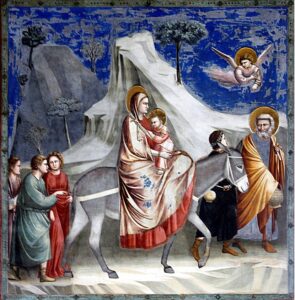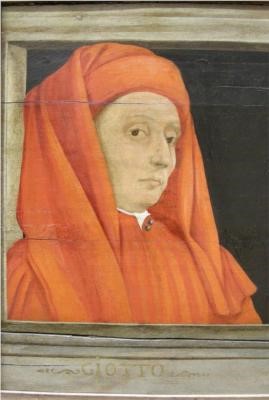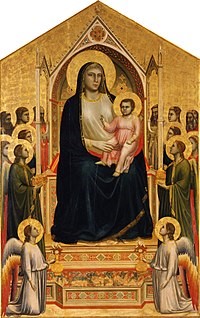Giotto
Grades 7+
The year is approximately 1277. We are outside Florence, in the middle of Italy. Cimabue, one of the two greatest painters of his time, walks through a field and comes across a shepherd boy using charcoal and rocks to draw pictures of his sheep. The boy, Giotto di Bondone, is a merry, intelligent child loved by all who know him. Cimabue is struck by how lifelike the pictures are. He asks the parents if the boy can come into the city to be his apprentice, which is a great honor. The parents agree. (5)
OR
Giotto’s family is quite wealthy, and upon moving to Florence they arrange for Cimabue to accept the boy into his studio.

The Flight into Egypt

Regardless of which version of his early history is true, Giotto matures into Florence’s most renowned artist – so prominent that the Pope sends a messenger asking Giotto to send him back a small picture. It is an honor, but there is a hidden motive. The Pope is looking for a painting to work in the Benedictine philosophical tradition. It’s the philosophy of the Benedictine Order, which insists that everyone should obey the Church’s every command.
But Giotto loves the philosophy of St. Francis, who believes that compassion rather than conformity should rule one’s life. Giotto wants the work but wants to paint what he wants, not what the Pope wants. It’s a difficult decision, because upsetting the Pope can get your career condemned and your life threatened or even ended.
Instead of doing a painting, Giotto draws a circle with red paint that is so perfect it seems as though it was drawn with a large compass. Giotto tells the messenger to give that to the Pope, which the man does. The Pope is so amazed that he hires Giotto and says he can paint whatever he wishes. (4)
Frescoes – paintings created in wet plaster – are Giotto’s specialty. His masterpieces are in the chapel at Padua. He was one of the first painters to paint people with natural-looking faces and actions. He also made considerable use of perspective, which gives pictures a sense of being more lifelike.
His paintings are also famous for his great storytelling ability. He shows the emotions of the characters in each painting, in both their faces and their body movement, and he arranges the figures in the painting so the viewers can feel as if they are there, participating in the event.
It’s also an “event” that includes little details that help bring it to life. For example, a Roman soldier in Bethlehem looks shameful as he pulls a child away from its mother. In the picture of Mary and Joseph on the way to Egypt, the people who are walking behind them are gossiping about them. And in his painting of the Madonna, St. Joseph, and the Christ Child, the Holy Family look like ordinary people. (3)

Ognissanti Madonna
Giotto Activity 1
Find the adjectives in the paragraphs with a parenthesis. The parentheses tell how many adjectives there are in the paragraph.